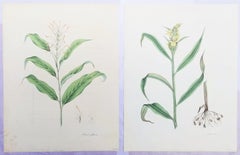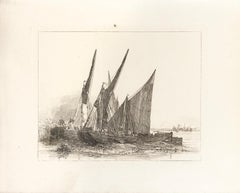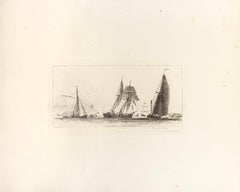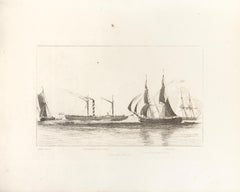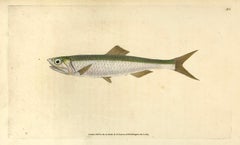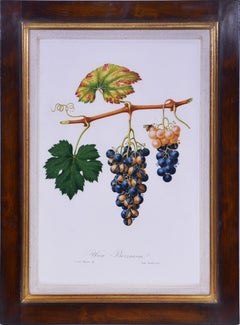Early 19th Century Art
to
1,031
1,522
283
196
71
58
Overall Width
to
Overall Height
to
7,526
20,755
155,828
236,873
1,876
2,278
4,816
6,385
5,903
13,135
20,098
24,810
17,373
13,278
5,319
565
295
58
4
3
2
2
1
1
1
1,072
1,006
18
1,539
731
542
469
363
346
315
174
162
154
139
75
71
70
66
66
62
53
46
46
920
698
388
301
285
311
48
26
24
20
563
865
977
471
Period: Early 19th Century
Set of Two Hand-Colored Lithographs from Roscoe's "Monandrian Plants" /// Botany
Located in Saint Augustine, FL
Artist: William Roscoe (English, 1753-1831)
Titles: "Hedychium Glaucum" and "Zingiber Elatum"
Portfolio: Monandrian Plants of the order Scitamineae, Chiefly Drawn from Living Specime...
Category
Victorian Early 19th Century Art
Materials
Watercolor, Lithograph
47: Barges
Located in Columbia, MO
Edward William Cooke was born in Pentonville. His father, George Cooke, and uncle William Bernard Cooke were also well-known line engravers. Growing up in an environment of artists,...
Category
Naturalistic Early 19th Century Art
Materials
Etching
53: Fishing Smack, Schooner, Sloop-rigged Barge
Located in Columbia, MO
Edward William Cooke was born in Pentonville. His father, George Cooke, and uncle William Bernard Cooke were also well-known line engravers. Growing up in an environment of artists,...
Category
Naturalistic Early 19th Century Art
Materials
Etching
48: Gravesend Steam Packet
Located in Columbia, MO
Edward William Cooke was born in Pentonville. His father, George Cooke, and uncle William Bernard Cooke were also well-known line engravers. Growing up in an environment of artists,...
Category
Naturalistic Early 19th Century Art
Materials
Etching
50: Clupea encrasicolus, Anchovy
Located in Columbia, MO
Edward Donovan (1768–1837) was an Anglo Irish writer, natural history illustrator and amateur zoologist. Born in Cork, Ireland, Donovan was an avid collector of natural history speci...
Category
Naturalistic Early 19th Century Art
Materials
Color, Etching
GALLESIO. A Group of Six Grapes.
Located in London, GB
Six hand-coloured plates of Grapes, printed in colour and finished by hand. Framed and glazed, overall size: 42.5 by 57.5cm. Pomona Italiana Ossia Trattato Degli Alberi Fruttiferi...
Category
Naturalistic Early 19th Century Art
Materials
Handmade Paper, Engraving
Early 19th Century Lithograph -- Beech Trees
By Henry William Burgess
Located in Soquel, CA
Rare early 19th Century lithograph laid on india paper, hand colored aquatint print, titled "Beech Trees in the Grounds of St. Leonards Hill, Berks, Seat o...
Category
Realist Early 19th Century Art
Materials
Black and White, Watercolor
$1,760 Sale Price
20% Off
31: Dutch Galliot
Located in Columbia, MO
Edward William Cooke was born in Pentonville. His father, George Cooke, and uncle William Bernard Cooke were also well-known line engravers. Growing up in an environment of artists,...
Category
Naturalistic Early 19th Century Art
Materials
Etching
43: Prawn boats, Brighton Beach
Located in Columbia, MO
Edward William Cooke was born in Pentonville. His father, George Cooke, and uncle William Bernard Cooke were also well-known line engravers. Growing up in an environment of artists,...
Category
Naturalistic Early 19th Century Art
Materials
Etching
26: Billy-Boy unloading, Shoreham Harbour
Located in Columbia, MO
Edward William Cooke was born in Pentonville. His father, George Cooke, and uncle William Bernard Cooke were also well-known line engravers. Growing up in an environment of artists,...
Category
Naturalistic Early 19th Century Art
Materials
Etching
96: Labrus julis, Indented-Striped Wrasse
Located in Columbia, MO
Edward Donovan (1768–1837) was an Anglo Irish writer, natural history illustrator and amateur zoologist. Born in Cork, Ireland, Donovan was an avid collector of natural history speci...
Category
Naturalistic Early 19th Century Art
Materials
Color, Etching
52: Oyster Boats at Billingsgate
Located in Columbia, MO
Edward William Cooke was born in Pentonville. His father, George Cooke, and uncle William Bernard Cooke were also well-known line engravers. Growing up in an environment of artists,...
Category
Naturalistic Early 19th Century Art
Materials
Etching
36: Brighton Fishing Boats
Located in Columbia, MO
Edward William Cooke was born in Pentonville. His father, George Cooke, and uncle William Bernard Cooke were also well-known line engravers. Growing up in an environment of artists,...
Category
Naturalistic Early 19th Century Art
Materials
Etching
Beauties of Claude Lorrain mezzotint - Plate 15
Located in Henderson, NV
Medium: etching, engraving and mezzotint (after Claude Lorrain). This lovely impression on wove paper was engraved by G.H. Every for the "Beauties of Claude Lorraine" portfolio. The ...
Category
Early 19th Century Art
Materials
Engraving, Mezzotint, Etching
Beauties of Claude Lorrain mezzotint - Plate 13
Located in Henderson, NV
Medium: etching, engraving and mezzotint (after Claude Lorrain). This lovely impression on wove paper was engraved by G.H. Every for the "Beauties of Claude Lorraine" portfolio. The ...
Category
Early 19th Century Art
Materials
Engraving, Mezzotint, Etching
32: Gasterosteus pungitius, Lesser or Ten Spined Stickleback
Located in Columbia, MO
Edward Donovan (1768–1837) was an Anglo Irish writer, natural history illustrator and amateur zoologist. Born in Cork, Ireland, Donovan was an avid collector of natural history speci...
Category
Early 19th Century Art
Materials
Color, Etching
"Torbay from Brixham Quay" engraving
Located in Henderson, NV
Medium: engraving (after the painting). Printed on Holland-style wove paper, from the rare large size deluxe portfolio entitled "Picturesque Views on the Southern Coast of England", ...
Category
Early 19th Century Art
Materials
Engraving
"St. Mawes, Cornwall" engraving
Located in Henderson, NV
Medium: engraving (after the painting). Printed on Holland-style wove paper, from the rare large size deluxe portfolio entitled "Picturesque Views on the Southern Coast of England", ...
Category
Early 19th Century Art
Materials
Engraving
29: The Discovery, Convict Ship
Located in Columbia, MO
Edward William Cooke was born in Pentonville. His father, George Cooke, and uncle William Bernard Cooke were also well-known line engravers. Growing up in an environment of artists,...
Category
Naturalistic Early 19th Century Art
Materials
Etching
14: Anchors
Located in Columbia, MO
Edward William Cooke was born in Pentonville. His father, George Cooke, and uncle William Bernard Cooke were also well-known line engravers. Growing up in an environment of artists,...
Category
Naturalistic Early 19th Century Art
Materials
Etching
40: The Hastings
Located in Columbia, MO
Edward William Cooke was born in Pentonville. His father, George Cooke, and uncle William Bernard Cooke were also well-known line engravers. Growing up in an environment of artists,...
Category
Naturalistic Early 19th Century Art
Materials
Etching
13: Dover Cliffs
Located in Columbia, MO
Edward William Cooke was born in Pentonville. His father, George Cooke, and uncle William Bernard Cooke were also well-known line engravers. Growing up in an environment of artists,...
Category
Naturalistic Early 19th Century Art
Materials
Etching
09: The Wolf Brig of War
Located in Columbia, MO
Edward William Cooke was born in Pentonville. His father, George Cooke, and uncle William Bernard Cooke were also well-known line engravers. Growing up in an environment of artists,...
Category
Naturalistic Early 19th Century Art
Materials
Etching
08: Dutch Boats
Located in Columbia, MO
Edward William Cooke was born in Pentonville. His father, George Cooke, and uncle William Bernard Cooke were also well-known line engravers. Growing up in an environment of artists,...
Category
Early 19th Century Art
Materials
Etching
The River Barge
By David Cox
Located in Fairlawn, OH
The River Barge
Pen and ink on paper on laid paper, mounted in English drum mount , c. 1810
Unsigned
Condition: Slight sun staining to sheet and mount in the window (see photo)
Image/sheet size: 5 1/4 x 6 11/16 inches
Sight: : 5-3/4 x 7-1/4"
Frame: 13-3/8 x 14-3/8"
Provenance: Colnaghi, London (see photo of label)
David Cox (29 April 1783 – 7 June 1859) was an English landscape painter, one of the most important members of the Birmingham School of landscape artists and an early precursor of Impressionism.
He is considered one of the greatest English landscape painters, and a major figure of the Golden age of English watercolour.
Although most popularly known for his works in watercolour, he also painted over 300 works in oil towards the end of his career, now considered "one of the greatest, but least recognised, achievements of any British painter.
His son, known as David Cox the Younger (1809-1885), was also a successful artist.
Early life in Birmingham, 1783–1804
Cox's birthplace in Deritend, Birmingham, illustrated by Samuel Lines
Cox was born on 29 April 1783 on Heath Mill Lane in Deritend, then an industrial suburb of Birmingham. His father was a blacksmith and whitesmith about whom little is known, except that he supplied components such as bayonets and barrels to the Birmingham gun trade. Cox's mother was the daughter of a farmer and miller from Small Heath to the east of Birmingham. Early biographers record that "she had had a better education than his father, and was a woman of superior intelligence and force of character." Cox was initially expected to follow his father into the metal trade and take over his forge, but his lack of physical strength led his family to seek opportunities for him to develop his interest in art, which is said to have first become apparent when the young Cox started painting paper kites while recovering from a broken leg.
By the late 18th century Birmingham had developed a network of private academies teaching drawing and painting, established to support the needs of the town's manufacturers of luxury metal goods, but also encouraging education in fine art, and nurturing the distinctive tradition of landscape art of the Birmingham School. Cox initially enrolled in the academy of Joseph Barber in Great Charles Street, where fellow students included the artist Charles Barber and the engraver William Radclyffe, both of whom would become important lifelong friends.
At the age of about 15 Cox was apprenticed to the Birmingham painter Albert Fielder, who produced portrait miniatures and paintings for the tops of snuffboxes from his workshop at 10 Parade in the northwest of the town. Early biographers of Cox record that he left his apprenticeship after Fielder's suicide, with one reporting that Cox himself discovered his master's hanging body, but this is probably a myth as Fielder is recorded at his address in Parade as late as 1825. At some time during mid-1800 Cox was given work by William Macready the elder at the Birmingham Theatre, initially as an assistant grinding colours and preparing canvases for the scene painters, but from 1801 painting scenery himself and by 1802 leading his own team of assistants and being credited in plays' publicity.
London, 1804–1814
In 1804 Cox was promised work by the theatre impresario Philip Astley and moved to London, taking lodgings in 16 Bridge Row, Lambeth. Although he was unable to get employment at Astley's Amphitheatre it is likely that he had already decided to try to establish himself as a professional artist, and apart from a few private commissions for painting scenery his focus over the next few years was to be on painting and exhibiting watercolours. While living in London, Cox married his landlord's daughter, Mary Agg and the couple moved to Dulwich in 1808.
David Cox Travellers on a Path, pencil and brown wash.
In 1805 he made his first of many trips to Wales, with Charles Barber, his earliest dated watercolours are from this year. Throughout his lifetime he made numerous sketching tours to the Home Counties, North Wales, Yorkshire, Derbyshire and Devon.
Cox exhibited regularly at the Royal Academy from 1805. His paintings never reached high prices, so he earned his living mainly as a drawing master. His first pupil, Colonel the Hon.H. Windsor (the future Earl of Plymouth) engaged him in 1808, Cox went on to acquire several other aristocratic and titled pupils. He also went on to write several books, including: Ackermanns' New Drawing Book (1809); A Series of Progressive Lessons (1811); Treatise on Landscape Painting (1813); and Progressive Lessons on Landscape (1816). The ninth and last edition of his series Progressive Lessons, was published in 1845.
By 1810 he was elected President of the Associated Artists in Water Colour. In 1812, following the demise of the Associated Artists, he was elected as associate of the Society of Painters in Water Colour (the old Water Colour Society). He was elected a Member of the Society in 1813, and exhibited there every year (except 1815 and 1817) until his death.
Hereford, 1814–1827
In the summer of 1813 Cox was appointed as the drawing master of the Royal Military College in Farnham, Surrey, but he resigned shortly afterwards, finding little sympathy with the atmosphere of a military institution. Soon after that he applied to a newspaper advertisement for a position as drawing master for Miss Crouchers' School for Young Ladies in Hereford and in Autumn 1814 moved to the town with his family. Cox taught at the school in Widemarsh Street until 1819, his substantial salary of £100 per year requiring only two-day's work per week, allowing time for painting and the taking of private pupils.
Cox's reputation as both a painter and a teacher had been building over previous years, as indicated by his election as a member of the Society of Painters in Water Colours and his inclusion in John Hassell's 1813 book Aqua Pictura, which claimed to present works by "all of the most approved water coloured draftsmen". The depression that accompanied the end of the Napoleonic Wars had caused a contraction in the art market, however, and by 1814 Cox had been very short of money, requiring a loan from one of his pupils to pay even for the move to Hereford. Despite its financial advantages and its proximity to the scenery of North Wales and the Wye Valley, the move to Hereford marked a retreat in terms of his career as a painter: he sent few works to the annual exhibition of the Society of Painters in Water Colours during his first years away from London and not until 1823 would he again contribute more than 20 pictures.
Between 1823 and 1826 he had Joseph Murray Ince as a pupil.
London, 1827–1841
He made his first trip to the Continent, to Belgium and the Netherlands in 1826 and subsequently moved to London the following year.
He exhibited for the first time with the Birmingham Society of Artists in 1829, and with the Liverpool Academy in 1831. In 1839, two of Cox's watercolours were bought from the Old Water Colour Society exhibition by the Marquis of Conynha for Queen Victoria.
Birmingham, 1841–1859
Greenfield House in Harborne, Birmingham – where Cox lived from 1841 until his death in 1859 .
In May 1840 Cox wrote to one of his Birmingham friends: "I am making preparations to sketch in oil, and also to paint, and it is my intention to spend most of my time in Birmingham for the purpose of practice". Cox had been considering a return to painting in oils since 1836 and in 1839 had taken lessons in oil painting from William James Müller, to whom he had been introduced by mutual friend George Arthur Fripp. Hostility between the Society of Painters in Water Colours and the Royal Academy made it difficult for an artist to be recognised for work in both watercolour and oil in London, however, and it is likely that Cox would have preferred to explore this new medium in the more supportive environment of his home town. By the early 1840s his income from sales of his watercolours was sufficient to allow him to abandon his work as a drawing master, and in June 1841 he moved with his wife to Greenfield House in Harborne, then a village on Birmingham's south western outskirts. It was this move that would enable the higher levels of freedom and experimentation that were to characterise his later work.
The elderly Cox pictured by Samuel Bellin in 1855.
In Harborne, Cox established a steady routine – working in watercolour in the morning and oils in the afternoon. He would visit London every spring to attend the major exhibitions, followed by one or more sketching excursions, continuing the pattern that he had established in the 1830s. From 1844 these tours evolved into a yearly trip to Betws-y-Coed in North Wales to work outdoors in both oil and watercolour, gradually becoming the focus for an annual summer artists colony that continued until 1856 with Cox as its "presiding genius".
Cox's experience of trying to exhibit his oils in London was short and unsuccessful: in 1842 he made his only submission to the Society of British Artists; one oil painting was exhibited at each of the British Institution and the Royal Academy in 1843; and two oil paintings were exhibited at the Royal Academy in 1844 – the last that would be exhibited in London during his lifetime.
Cox showed regularly at the Birmingham Society of Arts and its successor, the Birmingham Society of Artists, becoming a member in 1842.
Cox suffered a stroke on 12 June 1853 that temporarily paralysed him, and permanently affected his eyesight, memory and coordination.
By 1857 however, his eyesight had deteriorated. An exhibition of his work was arranged in 1858 by the Conversazione Society Hampstead, and in 1859 a retrospective exhibition was held at the German Gallery Bond Street, London. Cox died several months later. He was buried in the churchyard of St Peters, Harborne, Birmingham, under a chestnut tree, alongside his wife Mary.
Work
Early work
In the spring of 1811 Cox made a small number of notable works in oils during a visit to Hastings with his family. It is not known why he didn't continue working in this medium at the time, but the five known surviving examples were described in 1969 as "surely some of the most brilliant examples of the genre in England".
Mature work
Cox reached artistic maturity after his move to Hereford in 1814. Although only two major watercolours can confidently be traced to the period between Cox's arrival in the town and the end of the decade, both of these – Butcher's Row, Hereford of 1815 and Lugg Meadows, near Hereford of 1817 – mark advances on his earlier work.
Later work
Cox's later work produced after his move to Birmingham in 1841 was marked by simplification, abstraction and a stripping down of detail. His art of the period combined the breadth and weight characteristic of the earlier English watercolour school, together with a boldness and freedom of expression comparable to later impressionism. His concern with capturing the fleeting nature of weather, atmosphere and light was similar to that of John Constable, but Cox stood apart from the older painter's focus on capturing material detail, instead employing a high degree of generalisation and a focus on overall effect.
The quest for character over precision in representing nature was an established characteristic of the Birmingham School of landscape artists with which Cox had been associated early in his life, and as early as 1810 Cox's work had been criticised for its "sketchiness of finish" and "cloudy confusion of objects", which were held to betray "the coarseness of scene-painting". During the 1840s and 1850s Cox took this "peculiar manner" to new extremes, incorporating the techniques of the sketch into his finished works to a far greater degree.
Cox's watercolour technique of the 1840s was sufficiently different from his earlier methods to need explanation to his son in 1842, despite the fact that his son had been helping him teach and paint since 1827. The materials used for his later works in watercolour also differed from his earlier periods: he used black chalk instead of graphite pencil as his primary drawing medium, and the rough and absorbent "Scotch" wrapping paper for which he became well-known – both of these were related to his development of a rougher and freer style.
Influence and legacy
By the 1840s Cox, alongside Peter De Wint and Copley Fielding, had become recognised as one of the leading figures of the English landscape watercolour style of the first half of the 19th century. This judgement was complicated by reaction to the rougher and bolder style of Cox's later Birmingham work, which was widely ignored or condemned. While by this time De Wint and Fielding were essentially continuing in a long-established tradition, Cox was creating a new one.
A group of young artists working in Cox's watercolour style emerged well before his death, including William Bennett, David Hall McKewan and Cox's son David Cox Jr. By 1850 Bennett in particular had become recognised as "perhaps the most distinguished among the landscape painters" for his Cox-like vigorous and decisive style. Such early followers concentrated on the example of Cox's more moderate earlier work and steered clear of what were then seen as the excesses of Cox's later years. During a period dominated by sleek and detailed picturesque landscape, however, they were still condemned by publications such as The Spectator as "the 'blottesque' school", and failed to establish themselves as a cohesive movement.
John Ruskin in 1857 condemned the work of the Society of Painters in Water-colours as "a kind of potted art, of an agreeable flavour, suppliable and taxable as a patented commodity", excluding only the late work of Cox, about which he wrote "there is not any other landscape which comes near these works of David Cox in simplicity or seriousness".
An 1881 book, A Biography of David Cox: With Remarks on His Works and Genius, was based on a manuscript by Cox's friend William Hall, edited and expanded by John Thackray Bunce, editor of the Birmingham Daily Post.
There are two Blue Plaque memorials commemorating him at 116 Greenfield Road, Harborne, Birmingham, and at 34 Foxley Road, Kennington, London, SW9, where he lived from 1827. It can also be seen at the David Cox exhibition in Birmingham.
His pupils included Birmingham architectural artist, Allen Edward...
Category
Romantic Early 19th Century Art
Materials
Ink
Early 19th Century Watercolour - Saint George And The Dragon
Located in Corsham, GB
A charming 19th Century watercolour depiction of the dramatic slaying of the dragon by Saint George. The artist's use of vibrant colour and delicate line work make this a true feast ...
Category
Early 19th Century Art
Materials
Watercolor
$390 Sale Price
20% Off
Amorous Couple
Located in Fairlawn, OH
Amorous Couple
Watercolor on laid paper, c. 1810
Unsigned
Provenance: Emile Wolf (1899-1996)
The art collection of Emile Wolf was dispersed by Sotheby and Stair Galleries.
Condition: Excellent
22K gold leaf finishes corner frame (see photo)
“Mr. Wolf’s collection reflects a lifelong commitment to the arts. Although a mainstay of the Old Masters art scene in New York, Mr. Wolf’s collection spanned centuries and genres. He was an impassioned collector, and his Fifth Avenue apartment was filled with paintings and drawings that hung from floor to ceiling in every room. Space void of art was lined with an extensive library of art books that fueled his ardent collecting. Mr. Wolf took great joy in sharing this collection and his ideas with art historians, collectors, dealers and university students.
The Wolf collection included masterworks from every influential and groundbreaking Impressionist and modern artist of the late 19th and early 20th centuries, ranging from an outstanding grouping of works on paper by Picasso, Pissarro, and Cezanne to a Renoir oil...
Category
Romantic Early 19th Century Art
Materials
Watercolor
02: Fishing Boat Arrived
Located in Columbia, MO
Edward William Cooke was born in Pentonville. His father, George Cooke, and uncle William Bernard Cooke were also well-known line engravers. Growing up in an environment of artists,...
Category
Early 19th Century Art
Materials
Etching
Fisherman & his Catch
Located in Chesterfield, MI
Inuit carvings, created by the Inuit people living in or near the Arctic Circle, are a kind of sculpture (done with bone, ivory, wood or stone) depicting their traditional way of lif...
Category
Other Art Style Early 19th Century Art
Materials
Stone
$160 Sale Price
20% Off
Chinese Pith Painting of Fish
Located in Palm Beach, FL
Rare framed and matted antique Chinese painting of fish. Painted on pith paper with gouache in bold colors in a scholastic style. Having the expected ...
Category
Other Art Style Early 19th Century Art
Materials
Gouache
American Early 19th Century - Silkwork Picture with Figures
Located in Corsham, GB
Rare American silkwork picture. Presented in a charming gilt-effect frame with glazing. On linen.
Category
Early 19th Century Art
Materials
Tapestry
$464 Sale Price
20% Off
Joseph Mossmer (1780-1845) - 1810 Watercolour, The Road Home
Located in Corsham, GB
A fine watercolour study depicting a man, horse and dog bringing a cart back from town on a winding path. The artist demonstrates a great ability to portray distance in the different...
Category
Early 19th Century Art
Materials
Watercolor
$476 Sale Price
20% Off
A Group of Six Pears.
Located in London, GB
POITEAU, A. and P. TURPIN.
Traité des arbres fruitiers: A Group of six Pears.
H. Perronneau for T. Delachausée, Paris, 1807-1835.
A group of six stipple-engraved plates printed in c...
Category
Naturalistic Early 19th Century Art
Materials
Engraving
$10,008
Di Pietro della Valle, Landscape with fisherman
Located in Milan, IT
Pietro Della Valle (Livorno, 1819 - Florence, 1880)
Landscape with shepherdesses and fisherman, 1846
Oil on canvas, 34 x 50 cm
Framed, 64 x 69 cm
Pietro Della Valle (Leghorn 181...
Category
Other Art Style Early 19th Century Art
Materials
Canvas, Oil
Attrib. John A. Atkinson (1775-1833) - Framed Watercolour, Hungry Workhorse
Located in Corsham, GB
A charming watercolour study of aworkhorse resting in a walled paddock. The cacti to the background suggests a Mediterranean environment. Faintly inscribed to the reverse of the wate...
Category
Early 19th Century Art
Materials
Watercolor
Pear Engraving
Located in New York, NY
Redouté, Pierre Joseph.
Poire Tarquin. Le Choix des Plus Belles Fleurs.
Paris, 1827.
Original engraving hand colored at the time of publication.
Category
Early 19th Century Art
Materials
Paper
Samuel Austin (1796-1834) - 1831 Watercolour, Heron on the Rocks
By Samuel Austin
Located in Corsham, GB
A charming watercolour scene depicting a river flowing between banks with fallen trees. Perched on a rock in the center of the river a heron looks for fish in the stream. Signed and ...
Category
Early 19th Century Art
Materials
Watercolor
$628 Sale Price
20% Off
Whitehaven, Cumbria engraving by Elizabeth Byrne after Joseph Farington RA
Located in London, GB
To see more, scroll down to "More from this Seller" and below it click on "See all from this Seller."
Elizabeth Byrne (1777 - 1849) after Joseph Farington RA (1747 - 1821)
North View of Whitehaven, Cumbria
Hand-coloured engraving
27.5 x 56.5 cm
A view of the cliffs and port of Whitehaven in Cumbria.
Joseph Farington RA was an 18th-century English landscape painter and diarist. He drew a north and south view of Whitehaven, which were engraved by Elizabeth Byrne in the early 19th century. Byrne was a London-born etcher and landscape painter, who was taught by her father, the etcher William Byrne...
Category
Realist Early 19th Century Art
Materials
Engraving
1804 St George's Chapel Windsor Castle print
Located in London, GB
From a series of large and impressive prints of St George's Chapel, the location for the Royal Wedding of Prince Harry and Meghan Markle; to see some ...
Category
Realist Early 19th Century Art
Materials
Etching, Aquatint
1804 Etching St George's Chapel Windsor Castle Architectural Prince Harry Meghan
Located in London, GB
From a series of architectural prints of St George's Chapel; to see some others, scroll down to "More from this Seller" and below it click on "See all from this Seller."
Frederick Nash (1782-1856) Drawn and etched
Engraved by F C Lewis
Arches and Columns
London Published by F Nash, No 6 Asylum Buildings, Westminster Road July 12 1804
55x39cm
Frederick Nash was born in Lambeth. Initially studying architectural drawing under Thomas Malton he subsequently enrolled at the Royal Academy of Arts. From 1801 to 1809 he worked with the antiquarians John Britton...
Category
Realist Early 19th Century Art
Materials
Engraving, Etching
Quicksilver Royal Mail and The Blenheim
Located in Douglas, Isle of Man
James Pollard 1792-1867, was an English painter and watercolourist. Pollard was born in North London he was the son of a painter and publisher. He exhibited at the Royal Academy, Suf...
Category
Early 19th Century Art
Materials
Paper, Printer's Ink, Watercolor
Chinese Craft on the Pearl River.
Located in London, GB
[CHINESE SCHOOL].
Chinese Craft on the Pearl River.
Canton, circa 1810.
A pencil, water colour and body colour drawing of craft, heightened with white on paper watermarked ‘J Whatm...
Category
Naturalistic Early 19th Century Art
Materials
Watercolor
Early 19th Century Regency Watercolour - Portrait of Three Siblings
Located in Corsham, GB
A very fine watercolour portrait of a child and two infants, sitting on a velvet chair and cushion on a rose covered terrace. Dating to the Regency period, this remarkable work is be...
Category
Early 19th Century Art
Materials
Watercolor
$472 Sale Price
20% Off
Studies of seated figures
Located in Paris, Île-de-France
GIUSEPPE BOSSI
(1777-1815)
Studies of seated figures
Pen and ink on paper
18 x 14 cm
Provenance:
Private collection, France
Giuseppe Bossi was an Italian Neoclassical painter, dra...
Category
Old Masters Early 19th Century Art
Materials
Ink
Chinese Craft on the Pearl River.
Located in London, GB
[CHINESE SCHOOL].
Chinese Craft on the Pearl River.
Canton, circa 1810.
Pencil, water colour and body colour drawings of craft, heightened with white on paper watermarked ‘J Whatm...
Category
Naturalistic Early 19th Century Art
Materials
Watercolor
Self-portrait in Indonesian Landscape
Located in Amsterdam, NL
Abraham Johannes Romswinckel (1810-1856)
Self-portrait in Indonesian landscape
Inscribed Abr. Joh. Romswinckel, geb. Batavia 17 Oct. 1810, overl...
Category
Romantic Early 19th Century Art
Materials
Canvas, Oil
Pears (Bergamot de Chantilly, Bouchee, Winter Sweet Sugar Pear, Bishop's Thumb)
Located in Saint Augustine, FL
Artist: George Brookshaw (English, 1751-1823)
Title: "Pears (Bergamot de Chantilly, Bouchee, Winter Sweet Sugar Pear, Bishop's Thumb)" (Plate LXXIX)
Portfolio: Pomona Britannica, or A Collection of the Most Esteemed Fruits
Year: 1808 (First edition)
Medium: Original Aquatint and Stipple Engraving with Printed and Hand-Coloring on wove paper
Limited edition: Unknown
Printer: T. Bensley, London, UK
Publisher: George Brookshaw, London, UK
Reference: Dunthorne No. 50; "Great Flower Books" - No. 81; Nissen BBI No. 244; "An Oak Spring Pomona" No. 40a; Prideaux No. 295
Framing: Framed in a silver/gold moulding
Framed size: 22.94" x 18.88"
Sheet size: approx. 22.25" x 17.5"
Image size: 16.25" x 12.25"
Condition: Light toning to sheet. One unobtrusive foxmark lower center right. In otherwise very good condition
Rare
Notes:
Provenance: private collection - Orlando, FL; acquired from The Old Print Shop, New York, NY retaining their original gallery label lower center on verso. Comes from Brookshaw's famous book volume "Pomona Britannica", (1804-1812) which consists of 90 aquatint engravings some with stipple printed...
Category
Victorian Early 19th Century Art
Materials
Watercolor, Engraving, Aquatint
"Uditore di Rota. Suddiacono Apostolico" - Etching by Giuseppe Capparoni - 1828
Located in Roma, IT
"Uditore di Rota. Suddiacono Apostolico" is an Artwork realized in 1828 by the Engraver, Giuseppe Capparoni (Rome 1800- 1879).
Etching hand colored on ivory paper. Signed on plate a...
Category
Modern Early 19th Century Art
Materials
Etching
The Greek Deacon - Etching by Giuseppe Capparoni - 1828
Located in Roma, IT
The Greek Deacon is an Artwork realized in 1828 by the Engraver, Giuseppe Capparoni (Rome 1800- 1879).
Etching hand colored on ivory paper. Signed on plate and dated on the right ma...
Category
Modern Early 19th Century Art
Materials
Etching
$180 Sale Price
25% Off
The Cardinal Dean - Etching by Giuseppe Capparoni - 1827
Located in Roma, IT
The Cardinal Dean is an Artwork realized in 1827 by the Engraver, Giuseppe Capparoni (Rome 1800- 1879).
Etching hand colored on ivory paper. Signed on plate and dated on the right m...
Category
Modern Early 19th Century Art
Materials
Etching
"Servo Pontificio detto de Virga rubea" - Etching by Giuseppe Capparoni - 1827
Located in Roma, IT
"Servo Pontificio detto de Virga rubea" is an Artwork realized in 1827 by the Engraver, Giuseppe Capparoni (Rome 1800- 1879).
Etching hand colored on ivory paper. Signed on plate a...
Category
Modern Early 19th Century Art
Materials
Etching
Benevolent Cottagers /// English Landscape Figurative Village Scene Engraving
Located in Saint Augustine, FL
Artist: (after) Sir Augustus Wall Callcott (English, 1779-1844)
Title: "Benevolent Cottagers"
Year: 1816
Medium: Original Etching and Engraving on laid paper
Limited edition: Unknown...
Category
Old Masters Early 19th Century Art
Materials
Engraving, Etching, Laid Paper, Intaglio
"Cameriere Segreto Cavaliere di Spada, e Cappa" by Giuseppe Capparoni - 1827
Located in Roma, IT
The Noble Pontifical Guard is an Artwork realized in 1827 by the Engraver, Giuseppe Capparoni (Rome 1800- 1879).
"Cameriere Segreto Cavaliere di Spada, e Cappa" is an Artwork realiz...
Category
Modern Early 19th Century Art
Materials
Etching
Pumpkin patch oil on canvas
Located in San Francisco, CA
Pumpkin patch
oil on canvas
No visible signature
16 x 24 on framed, 19.75 x 27.75 framed
Category
Early 19th Century Art
Materials
Canvas, Oil
"Cursore Pontificio" - Etching by Giuseppe Capparoni - 1827
Located in Roma, IT
"Cursore Pontificio" is an Artwork realized in 1827 by the Engraver, Giuseppe Capparoni (Rome 1800- 1879).
Etching hand colored on ivory paper. Signed on plate and dated on the righ...
Category
Modern Early 19th Century Art
Materials
Etching
Gentleman of the Cardinal - Etching by Giuseppe Capparoni - 1827
Located in Roma, IT
Gentleman of the Cardinal is an Artwork realized in 1827 by the Engraver, Giuseppe Capparoni (Rome 1800- 1879).
Etching hand colored on ivory paper. Signed on plate and dated on the...
Category
Modern Early 19th Century Art
Materials
Etching
"Caudatario" in the Chapel - Etching by Giuseppe Capparoni - 1827
Located in Roma, IT
"Caudatario" in the Chapel is an Artwork realized in 1827 by the Engraver, Giuseppe Capparoni (Rome 1800- 1879).
Etching hand colored on ivory paper. Signed on plate and dated on th...
Category
Modern Early 19th Century Art
Materials
Etching
New Year From the Series Precious Children's Games of the Five Festivals
Located in Houston, TX
Torii Kiyonaga woodblock print from the series "Prescious Children's Games of the Five Festivals." It shows five children playing with a ball and kites flying in the background. This...
Category
Edo Early 19th Century Art
Materials
Woodcut
Chinese Craft on the Pearl River.
Located in London, GB
[CHINESE SCHOOL].
Chinese Craft on the Pearl River.
Canton, circa 1810.
A pencil, water colour and body colour drawing of craft, heightened with white on paper watermarked ‘J Whatm...
Category
Other Art Style Early 19th Century Art
Materials
Watercolor
Black Frontiniac Grapes by George Brookshaw
Located in New York, NY
Plate LVII, Black Frontiniac, from "Pomona Britannica..." by George Brookshaw. London, T. Bensley for the author, 1804-1812. Original aquatint with stipple engraving, color printed...
Category
Early 19th Century Art
Materials
Paper
Recently Viewed
View AllMore Ways To Browse
18th Century Dutch Oil Paintings
19th Century Oil Painting Pastoral Scene
1965 Watch
Wrestler Sculpture
15th Century Italian Painting
Wrestling Vintage
1962 Watch
18th Century Oil Painting Woman
1965 Vintage Watch
1984 Clothing
19th Century Painting Lovers
Woman Posing Seated
1974 Vintage Watch
1930s Actress
1953 Watch
Wood Carving Portrait
18th Century Venetian Paintings
1980 Japanese Poster
